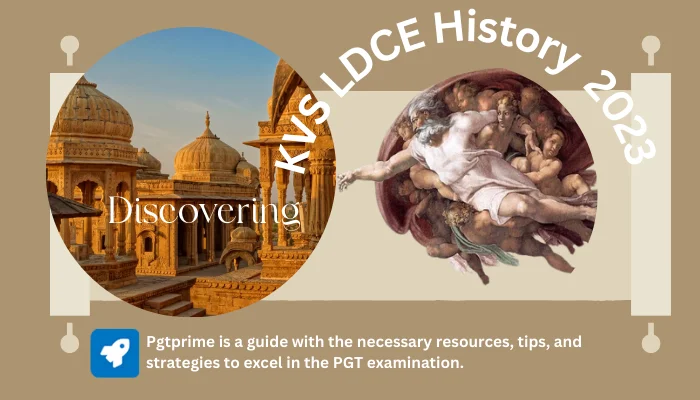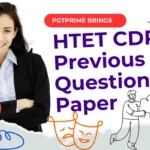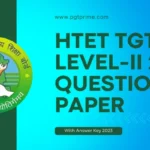👉FROM (Q.81-To-Q.100)
81. Which one of the following places did the British forces led by Campbell killed over 2000 rebel sepoys in India?
- Jallianwallah Bagh in Amritsar
- Secundrah Bagh in Lucknow
- Company Bagh in Bharatpur
- Ram Bagh in Jaipur
Answer: KVS LDCE History Question Paper and Answers PDF 2023
(2) Secundrah Bagh in Lucknow
In March 1858, British forces, under the command of Brigadier-General Henry Havelock, launched an assault on Secundrah Bagh to quell the rebellion. The Bagh was heavily fortified, and the British forces faced fierce resistance from the rebels. Eventually, the British breached the walls and engaged in a bloody confrontation with the rebels.
82. Which one of the following was not a feature of militarization of Japan under Emperor Meiji?
- The new Meiji government forced the tribal warlords belonging to Choshu, Satsuma, Tosa and Hizen to surrender their lands to the Emperor
- They replaced the old socio-political structure with a new one
- The economic privileges of the Samurai class were wiped out completely
- To renovate the military, the new Meiji leaders introduced Army Conscription
Answer: KVS LDCE History Question Paper and Answers PDF 2023
(1) The new Meiji government forced the tribal warlords belonging to Choshu, Satsuma, Tosa and Hizen to surrender their lands to the Emperor
Meiji government sought to dismantle the power of regional domains and feudal lords. The tribal warlords, known as daimyo, were indeed forced to surrender their lands and authority to the Emperor. This was done to centralize political control and create a more unified Japan under the Emperor’s rule.
83. Who donated hundred acres of land to Vinoba Bhave in 1951, that encouraged Vinoba to start ‘Bhoodan’movement?
- Vedre Ramchandra Reddy
- Nukala Ram Reddy
- Konda Venkataram Reddy
- Pingali Venkatram Reddy
Answer: KVS LDCE History Question Paper and Answers PDF 2023
(1) Vedre Ramchandra Reddy
He donated a hundred acres of land to Vinoba Bhave in 1951, which played a significant role in inspiring Vinoba to initiate the ‘Bhoodan‘ (land gift) movement. This movement aimed to persuade wealthy landowners to voluntarily donate land to be distributed among landless farmers and promote social justice and equality in rural areas.
84. Chronologically arrange the Muslim Congress Presidents on the basis of their year of Presidentship.
- Syed Badruddin Tyabji
- Rahimatullah M. Sayani
- Syed Hassan Imam
- Maulana Abul Kalam Azad
Choose the correct Answer from the options given below : KVS LDCE History Question Paper and Answers PDF 2023
- (a), (b), (c), (d)
- (c), (b), (a), (d)
- (b), (a), (c), (d)
- (a), (c), (d), (b)
Answer: KVS LDCE History Question Paper and Answers PDF 2023
(1) (a), (b), (c), (d)
- Syed Badruddin Tyabji: He served as the President of the Indian National Congress in 1887. He was the first Muslim to hold the position.
- Rahimatullah M. Sayani: He served as the President of the Indian National Congress in 1907. Sayani was a prominent lawyer and social reformer.
- Syed Hassan Imam: He served as the President of the Indian National Congress in 1919. He played a significant role in the Khilafat movement and was known for his efforts towards Hindu-Muslim unity.
- Maulana Abul Kalam Azad: He served as the President of the Indian National Congress in 1940. Maulana Azad was a prominent leader of the Indian independence movement and a strong advocate for Hindu-Muslim unity.
85. Which one of the following rebels of 1857 who mobilised the peasantry in Meerut region and was killed in a battle in July 1857?
- Maulvi Ahmadullah Shah
- Shah Mal
- Kunwar Singh
- Nana Sahib
Answer: KVS LDCE History Question Paper and Answers PDF 2023
(2) Shah Mal
Sah Mal was a prominent rebel leader during the Indian Rebellion of 1857. He mobilized and organized the peasantry in the Meerut region to participate in the uprising against British rule.
However, Shah Mal’s involvement in the rebellion was short-lived, as he was killed in a battle against the British forces in July 1857. Despite his death, his efforts and sacrifice served as an inspiration for others to continue the fight for independence during the rebellion.
86. Which one of the following committees prepared the details of the Wardha Scheme of Basic Education?
- Motilal Nehru Committee
- Dr. Zakir Hussain Committee
- Dr. Radhakrishnan Committee
- Dr. Vishveswariya Committee
Answer: KVS LDCE History Question Paper and Answers PDF 2023
(2) Dr. Zakir Hussain Committee
The Dr. Zakir Hussain Committee, also known as the Basic Education Committee, was established in 1937 to prepare the details of the Wardha Scheme of Basic Education.
The Wardha Scheme of Basic Education aimed to provide a comprehensive and holistic education system based on Gandhian principles. It emphasized practical and productive education, focusing on the overall development of students’ physical, intellectual, and moral faculties.
87. Who persuaded Gandhiji to come to Champaran to investigate the problem of Indigo Planters?
- Brij Kishore
- Raj Kumar Shukla
- Rajendra Prasad
- Acharya J.B. Kripalani
Answer: KVS LDCE History Question Paper and Answers PDF 2023
(2) Raj Kumar Shukla
Raj Kumar Shukla, a farmer from Champaran in Bihar, met Mahatma Gandhi during a train journey in 1917. He informed Gandhi about the issues faced by the indigo farmers in Champaran, who were being forced to cultivate indigo under oppressive conditions by British indigo planters. Raj Kumar Shukla passionately requested Gandhi to visit Champaran and help the farmers in their struggle for justice.
88. Match List I with List II and choose the correct Answer from the code given below :
| List I | List II |
| (Authors) | (Their Works) |
| (a) John William Kaye | (i) Eighteen Fifty-seven |
| (b) Edward J Thompson | (ii) A Histroy of the Sepoy War |
| (c) S.N. Sen | (iii) The Other Side of the Medal |
| (d) S.B. Choudhari | (iv) Civil Disturbances during British Raj |
Code: KVS LDCE History Question Paper and Answers PDF 2023
| (a) | (b) | (c) | (d) | |
| (1) | (iii) | (iv) | (i) | (ii) |
| (2) | (ii) | (iii) | (i) | (iv) |
| (3) | (i) | (iv) | (ii) | (iii) |
| (4) | (iv) | (iii) | (i) | (ii) |
Answer: KVS LDCE History Question Paper and Answers PDF 2023
(2) (ii) (iii) (i) (iv)
- John William Kaye, a British civil servant and historian, is indeed the author of “A History of the Sepoy War.” This book, also known as “The History of the Indian Mutiny,” provides a comprehensive account of the events surrounding the Indian Rebellion of 1857, commonly referred to as the Sepoy Mutiny or the First War of Indian Independence.
- Edward John Thompson was a British scholar, novelist, historian, and translator. He is remembered for his translations from Bengali into English and his association with Rabindranath Tagore. His work “The Other Side of the Medal” (1925), which examines the Revolt of 1857 from an Indian perspective
- S.N. Sen, also known as Surendra Nath Sen, was an Indian historian and writer who made notable contributions to the field of Indian history. “Eighteen Fifty-seven” is a historical book that focuses on the significant events and repercussions of the Indian Rebellion of 1857, also known as the Sepoy Mutiny or the First War of Independence.
- S. B Chudhary also known as Shashi Bhusan Choudary. This book gives an account of the resistance to British rule in India. They include all forms of rebellion, the revolts of ryots against their landed chiefs protected by the British, communal struggles, and political commotions originating from the policies of rulers.
89. Which one of the following European commercial companies set up their base at Masulipatnam in 1605?
- British
- French
- Dutch
- Portuguese
Answer: KVS LDCE History Question Paper and Answers PDF 2023
(3) Dutch
Masulipatnam was an important port on the Coromandel Coast of India, and the Dutch established their trading post there to engage in the spice trade and other commercial activities.
90. Which Bengali woman wrote a story of her life – Amar Jivan, in 1868?
- Tarini Devi
- Rassundari Devi
- Vina Mazumdar
- Kadambini Basu
Answer: KVS LDCE History Question Paper and Answers PDF 2023
(2) Rassundari Devi
The Bengali woman who wrote a story of her life titled “Amar Jivan” in 1868 was Rassundari Devi. Rassundari Devi was a Bengali writer and autobiographer who is known for her memoir that provides valuable insights into the life of women in 19th-century Bengal. Her work, “Amar Jivan,” is considered one of the earliest autobiographies written by an Indian woman.
91. When were the universities of Bombay, Madras and Calcutta established?
- 1947
- 1857
- 1757
- 1935
Answer: KVS LDCE History Question Paper and Answers PDF 2023
(2) 1857
The universities of Bombay, Madras, and Calcutta were established in the year 1857. These universities were among the earliest modern universities established in India during the British colonial period. These universities were:
- University of Bombay: The University of Bombay (now known as the University of Mumbai) was established on July 18, 1857. It was the first university to be set up in western India. The university initially functioned as an affiliating and examining body, overseeing the colleges and institutions in the Bombay Presidency region.
- University of Madras: The University of Madras was established on September 5, 1857. It was established as a result of the efforts of the British governor of Madras, Lord Elphinstone. The university aimed to provide higher education in various disciplines and to promote the study of Indian languages, literature, and culture.
- University of Calcutta: The University of Calcutta, also known as Calcutta University, was established on January 24, 1857. It was the first modern university in India and one of the oldest universities in the country. The university was founded by the efforts of scholars and educational reformists like Ishwar Chandra Vidyasagar and Henry Louis Vivian Derozio.
92. Who among the following did not become the President of the Indian National Congress
- George Yule
- A.O. Hume
- Sir Henry Cotton
- Rabindranath Tagore
Choose the correct Answer from the options given below : KVS LDCE History Question Paper and Answers PDF 2023
- (a), (b) and (d) only
- (b), (c) and (d) only
- (a) and (c) only
- (b) and (d) only
Answer: KVS LDCE History Question Paper and Answers PDF 2023
(4) (b) and (d) only
George Yule, and Sir Henry Cotton all served as Presidents of the Indian National Congress at different times. However, Rabindranath Tagore did not become the President of the Indian National Congress. A.O. Hume was a British civil servant and one of the founders of the Indian National Congress (INC).
93. In the wake of the Revolt of 1857-58, Emperor Bahadur Shah was tried, and where was he exiled by the British?
- Kathmandu
- Rangoon
- Kabul
- Peshawar
Answer: KVS LDCE History Question Paper and Answers PDF 2023
(2) Rangoon
After the Revolt of 1857-58, Emperor Bahadur Shah was tried by the British and subsequently exiled. He was sent into exile to Rangoon (present-day Yangon) in Burma (now Myanmar). He spent the rest of his life there until his death in 1862.
94. Match List I with List II and select the correct Answer from the code given below by putting the events in chronological order.
| List I | List II |
| (Event) | (Year) |
| (a) Gandhi-Irwin Pact | (i) 1905 |
| (b) Partition of Bengal | (ii) 1942 |
| (c) Jallianwallah Bagh Massacre | (iii) 1931 |
| (d) Quit India movement | (iv) 1919 |
Code: KVS LDCE History Question Paper and Answers PDF 2023
| (a) | (b) | (c) | (d) | |
| (1) | (iii) | (i) | (iv) | (ii) |
| (2) | (i) | (iv) | (ii) | (iii) |
| (3) | (ii) | (iii) | (i) | (iv) |
| (4) | (iv) | (ii) | (iii) | (i) |
Answer: KVS LDCE History Question Paper and Answers PDF 2023
(1) (iii) (i) (iv) (ii)
Partition of Bengal – This event occurred in 1905. It was a controversial decision by Lord Curzon, the Viceroy of India, to divide the province of Bengal into two separate administrative entities, Bengal and East Bengal. The partition was met with widespread protests and political opposition.
Jallianwallah Bagh Massacre – This tragic incident happened in 1919. General Reginald Dyer ordered the British Indian Army to open fire on a crowd of unarmed protestors at Jallianwallah Bagh in Amritsar, Punjab. Hundreds of people were killed and many more were injured, sparking outrage across India.
Gandhi-Irwin Pact – This event took place in 1931. It was an agreement signed between Mahatma Gandhi and Lord Irwin, the then Viceroy of India. The pact aimed to resolve the issues related to the civil disobedience movement and led to the release of political prisoners and a temporary truce between the Indian National Congress and the British government.
Quit India movement – This significant event occurred in 1942. It was a mass civil disobedience movement launched by the Indian National Congress under the leadership of Mahatma Gandhi. The movement aimed for India’s immediate independence from British rule and witnessed widespread participation and subsequent repression by the British authorities.
95. Match List I with List II and select the correct Answer from the code given below :
| List I | List II |
| (Conference/Meetings) | (Purpose/Theme) |
| (a) Yalta conference | (i) To discuss formation of UNO |
| (b) Dumbarton Oaks Conference | (ii) Germany’s unconditional surrender |
| (c) Tehran Meeting | (iii) Japan’s unconditional surrender |
| (d) Cairo Declaration | (iv) Agreement on a Second Front |
Code: KVS LDCE History Question Paper and Answers PDF 2023
| (a) | (b) | (c) | (d) | |
| (1) | (iii) | (i) | (iv) | (ii) |
| (2) | (i) | (ii) | (iii) | (iv) |
| (3) | (ii) | (i) | (iv) | (iii) |
| (4) | (iv) | (iii) | (ii) | (i) |
Answer: KVS LDCE History Question Paper and Answers PDF 2023
(3) (ii) (i) (iv) (iii)
(a) Yalta conference – (ii) Germany’s unconditional surrender
The Yalta Conference, held in 1945, was a meeting between the leaders of the Allied powers (Franklin D. Roosevelt, Winston Churchill, and Joseph Stalin). While the conference discussed various issues related to post-war Europe, it did not involve Germany’s unconditional surrender. Germany’s surrender was later achieved through the German Instrument of Surrender signed on May 7, 1945.
(b) Dumbarton Oaks Conference – (i) To discuss the formation of UNO
The Dumbarton Oaks Conference, held in 1944, was indeed a meeting to discuss the establishment of the United Nations Organization (UNO). Representatives from the United States, the United Kingdom, the Soviet Union, and China participated in the conference.
(c) Tehran Meeting – (iv) Agreement on a Second Front
The Tehran Conference, held in 1943, was a meeting between the leaders of the Allied powers (Franklin D. Roosevelt, and Winston Churchill). One of the key outcomes of the conference was an agreement on opening a Second Front against Germany in Western Europe, which was later realized through the Normandy landings in 1944.
(d) Cairo Declaration – (iii) Japan’s unconditional surrender
The Cairo Declaration, issued in 1943, was a joint statement by the United States, the United Kingdom, and China regarding their objectives for the post-war settlement with Japan. It called for Japan’s unconditional surrender, leading to the end of World War II in the Pacific.
96. Match List I with List II and select the correct Answer from the code given below :
| List I | List II |
| (Authors) | (Works/Newspapers) |
| (a) Annie Besant | (i) Comerade |
| (b) Maulana A.K. Azad | (ii) Bande Mataram |
| (c) Maulana Mohammad Ali | (iii) Al Hilal |
| (d) Aurobindo Ghosh | (iv) New India |
Code: KVS LDCE History Question Paper and Answers PDF 2023
| (a) | (b) | (c) | (d) | |
| (1) | (ii) | (iv) | (i) | (iii) |
| (2) | (iv) | (iii) | (i) | (ii) |
| (3) | (iv) | (iii) | (ii) | (i) |
| (4) | (i) | (iv) | (ii) | (iii) |
Answer: KVS LDCE History Question Paper and Answers PDF 2023
(2) (iv) (iii) (i) (ii)
Annie Besant was associated with the newspaper called “New India.” She served as its editor and used it as a platform to advocate for Indian independence and social reforms.
Maulana A.K. Azad was the editor of the newspaper “Al Hilal,” which played a significant role in promoting the cause of Indian independence and advocating for the rights of Muslims in India.
Maulana Mohammad Ali was associated with the newspaper “Comerade,” which he founded to promote the cause of Indian independence and to advocate for the rights of Muslims in India.
Aurobindo Ghosh was associated with the song “Bande Mataram.” He composed the song, which became a popular nationalist hymn during the Indian independence movement.
97. Arrange the following in chronological order :
- Formation of Ghadar Party
- Formation of All India Depressed Classes League
- Gandhiji’s Champaran Campaign
- Indian Universities Act
Select the correct Answer from the code given below :
Code: KVS LDCE History Question Paper and Answers PDF 2023
- (iv), (i), (iii), (ii)
- (i), (iv), (iii), (ii)
- (i), (iii), (ii), (iv)
- (iv), (iii), (ii), (I)
Answer: KVS LDCE History Question Paper and Answers PDF 2023
(1) (iv), (i), (iii), (ii)
The chronological order of the events is as follows:
- Indian Universities Act: The Indian Universities Act was passed in 1904. This act brought reforms to the higher education system in British India and aimed to modernize and regulate the functioning of universities. It introduced significant changes in the administration, curriculum, and governance of universities, emphasizing the role of the government in education.
- Formation of Ghadar Party: The Ghadar Party was formed in 1913 by Indian immigrants in the United States with the aim of seeking independence for India from British rule. The party played a significant role in organizing revolutionary activities against British rule.
- Gandhiji’s Champaran Campaign: Gandhiji’s Champaran Campaign took place in 1917 in Champaran, Bihar. It was one of Gandhiji’s first successful movements in India and involved the agitation against the oppressive indigo plantation system. Gandhiji mobilized the farmers and fought for their rights, leading to significant reforms in the indigo industry.
- Formation of All India Depressed Classes League: The All India Depressed Classes League was formed in 1930 by Dr. B.R. Ambedkar, a prominent social reformer and the champion of the rights of the oppressed and marginalized sections of society. The league aimed to address the social and political issues faced by the Dalits (formerly known as untouchables) and other oppressed communities.
98. Match List I with List II and select the correct Answer from the code given below :
| List I | List II |
| (Name of Freedom Fighter) | (Known as) |
| (a) Gopal Krishna Gokhale | (i) Extremist |
| (b) Bal Gangadhar Tilak | (ii) Revolutionary |
| (c) Bhagat Singh | (iii) Moderate |
| (d) Chittaranjan Das | (iv) Swarajist |
Code: KVS LDCE History Question Paper and Answers PDF 2023
| (a) | (b) | (c) | (d) | |
| (1) | (iii) | (i) | (ii) | (iv) |
| (2) | (iv) | (ii) | (i) | (iii) |
| (3) | (ii) | (iii) | (iv) | (i) |
| (4) | (i) | (iv) | (iii) | (ii) |
Answer: KVS LDCE History Question Paper and Answers PDF 2023
(1) (iii) (i) (ii) (iv)
Gopal Krishna Gokhale was a prominent leader of the Indian National Congress who advocated for constitutional reforms and gradual progress towards self-government within the British Empire. He was considered a moderate leader.
Bal Gangadhar Tilak, also known as Lokmanya Tilak, was a nationalist leader and one of the prominent voices of the Indian independence movement. He advocated for radical means to achieve self-rule and was associated with the extremist faction within the Indian National Congress.
Bhagat Singh was a revolutionary freedom fighter who played a significant role in the Indian independence movement. He was involved in acts of resistance against British rule and became an iconic figure for his courage and sacrifice.
Chittaranjan Das was a prominent leader and lawyer who advocated for the concept of “swaraj” (self-rule) in India. He was associated with the Swaraj Party, which was formed within the Indian National Congress and aimed to attain self-government through legislative means.
99. Given below are two statements. One labeled as Assertion (A) and the other labeled as Reason (R) :
- Assertion (A): Aboilition of slavery by an Act of Parliament of Britain in 1833 gave freedom to thousands of slaves working in the crown colonies.
- Reason (R): The indentured system to recruit labourers on contract from India to work on Plantations in the Crown Colonies was introdued in 1830s.
Find the correct Answer from the options below : KVS LDCE History Question Paper and Answers PDF 2023
- Both (A) and (R) are correct but (R) is not the correct explanation of (A)
- (A) is correct but (R) is false
- (A) is false, but (R) is correct
- Both (A) and (R) are correct and (R) is the correct explanation of (A)
Answer: KVS LDCE History Question Paper and Answers PDF 2023
(2) (A) is correct but (R) is false
The Assertion (A) is correct. The Abolition of slavery by an Act of Parliament in Britain in 1833 did grant freedom to thousands of slaves working in the crown colonies. The Act, known as the Slavery Abolition Act 1833, abolished slavery throughout the British Empire, including its colonies.
The Reason (R) is incorrect in relation to the given assertion. The indentured system to recruit laborers from India to work on plantations in the Crown Colonies was introduced earlier, not in the 1830s. The indenture system began in the early 19th century, with the first Indian indentured laborers sent to Mauritius in 1834, followed by other colonies like Trinidad, British Guiana (now Guyana), and Fiji. However, this reason does not directly explain the assertion made about the abolition of slavery in 1833.
100. Given below are two statements. One labeled as Assertion (A) and the other labeled as Reason (R) :
- Assertion (A): Under Lord Curzon’s administration university education was increasingly brought under official control.
- Reason (R): Lord Curzon wanted educated Indians to express loyalty towards the british rule.
Find the correct Answer from the options given below : KVS LDCE History Question Paper and Answers PDF 2023
- Both (A) and (R) are correct and (R) is the correct explanation of (A)
- (A) is correct but (R) is false
- (A) is false, but (R) is correct
- Both (A) and (R) are correct but (R) is not the correct explanation of (A)
Answer: KVS LDCE History Question Paper and Answers PDF 2023
(1) Both (A) and (R) are correct and (R) is the correct explanation of (A)
Lord Curzon, during his administration as the Viceroy of India (1899-1905), implemented policies that aimed to increase official control over university education in India, this is reflected in Assertion (A).
The Reason (R) provides the motivation behind Lord Curzon’s actions.Lord Curzon intended to shape the curriculum and governance of universities in a way that would promote loyalty to British rule among the educated Indian population.











